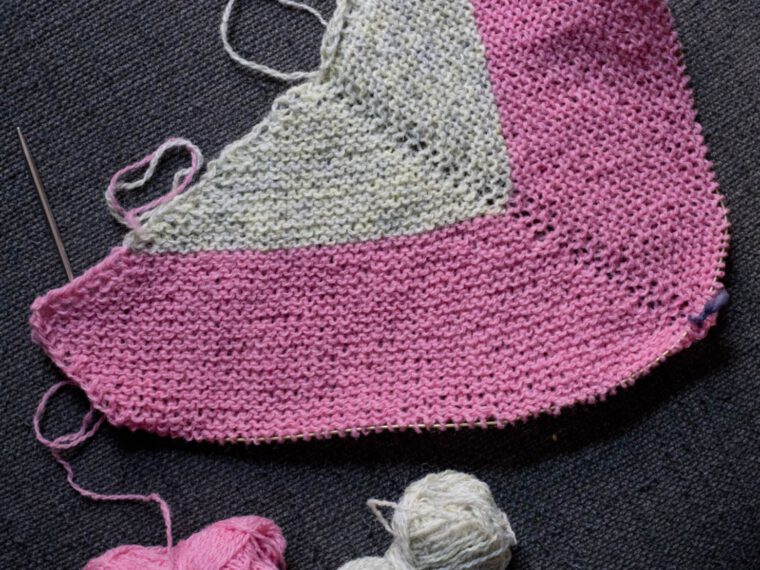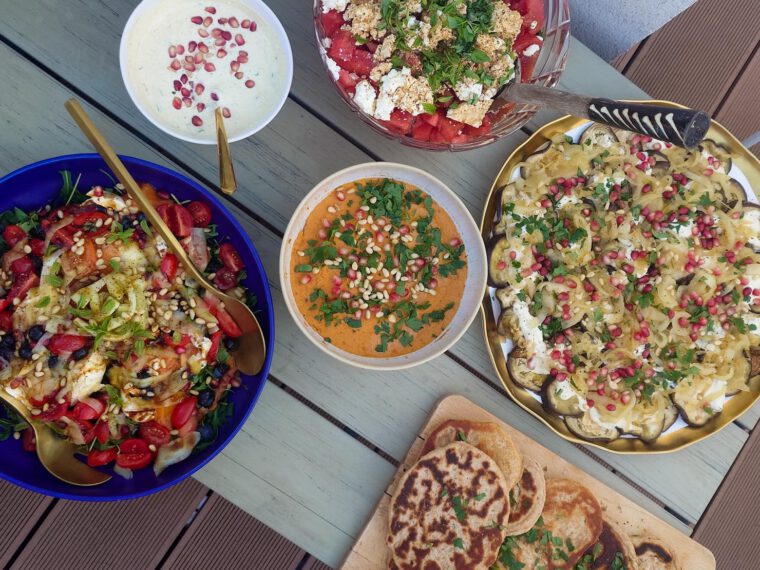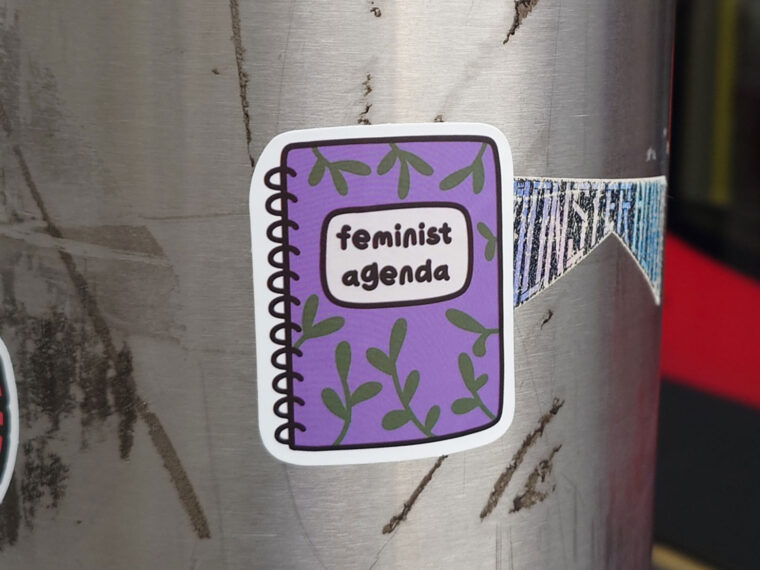…mit viel Gebackenem, drei Beiträgen fürs Radio, dreimal „auswärts“ essen/trinken (Good Morning Vietnam, Café Kandl und Matiki Bar) – und wie immer, den besten Links der letzten Tage.
Seit dem letzten Sonntagspost habe ich gar nicht wenig gebacken: Ananas-Fenchel-Kuchen, Olivenöl-Chocolate-Chunk-Cookies (nach Love & Olive Oil), die mich nicht besonders überzeugt haben, Kaiserschmarren nach Katha Seieser, Reiszopfbrot, Coffee Blondie Bars (nach the Vanilla Bean Blog), die fast zahnweh-süß waren, vegane Cookies (nach Minimalist Baker), die eher Makronen waren, eine Ahornsirup-Bacon-Torte (nach Nik Sharma) und Haferflockenscones (nach Smitten Kitchen).
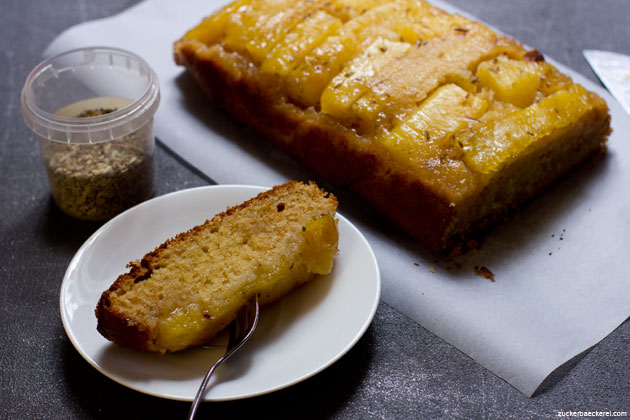
Ananas-Fenchel-Kuchen 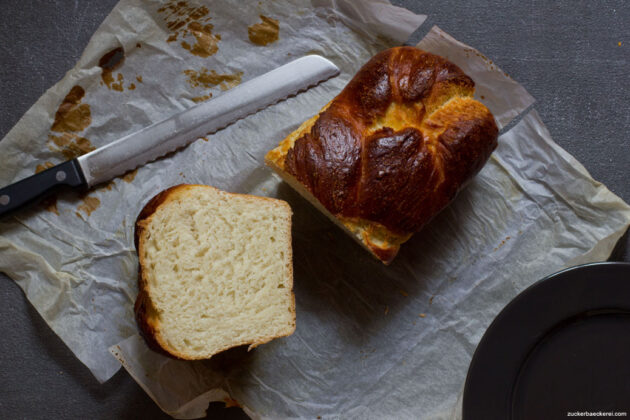
Reiszopfbrot
Radio
Schon im Januar war ich ausgestattet mit Aufnahmegerät und Mikrofonangel in der Papierwerkstatt von Beatrix Mapalagama. Aus diesem für mich superinteressanten Interview sind zwei Beiträge entstanden: „Eine Jeanshose aus Papier“ für Rudi Radiohund (leider schon depubliziert) und ein „Meisterstück“ (hier noch bis Donnerstag nachzuhören).
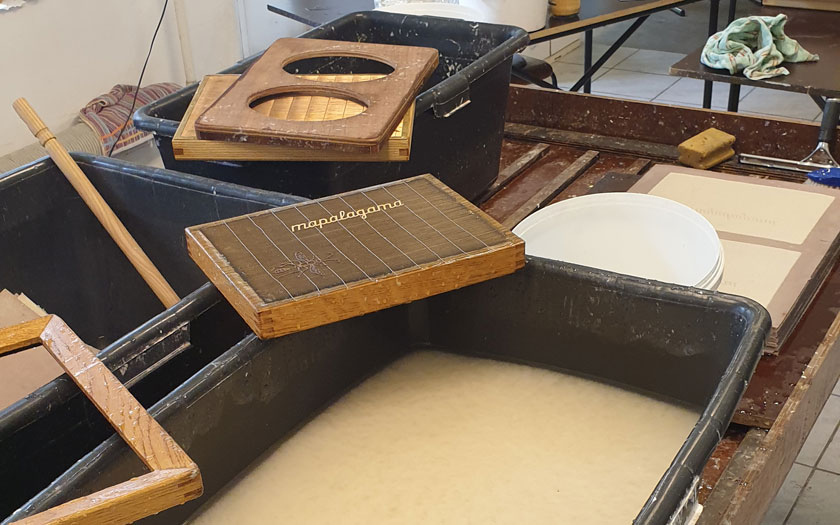
Daneben war ich sehr beschäftigt mit meiner neuesten Sendung für Moment Kulinarium, in deren Thema ich mich sehr motiviert hinein-nerdete: „Die Wissenschaft der Patisserie“. Noch bis kommenden Freitag in der Ö1-Radiothek nachzuhören. Hier im Podcastblog habe ich ein paar Absätze zur Entstehung der Sendung und der verwendeten Literatur aufgeschrieben.
Apropos Podcast: Am Dienstag um 18.30h findet das nächste Podcasting-Meetup, das ich mitorganisiere, statt. Mehr Infos und Anmeldung auf der Webseite der Podcasterei.
„Auswärts“ Essen und ein Cocktail to-go
Mit meiner üblichen Restaurantbegleitung habe ich bei Good Morning Vietnam bestellt, vor allem die Desserts haben es mir dabei angetan. Diesen „Restaurantabend daheim“ habe ich in diesem Post ausführlicher beschrieben.
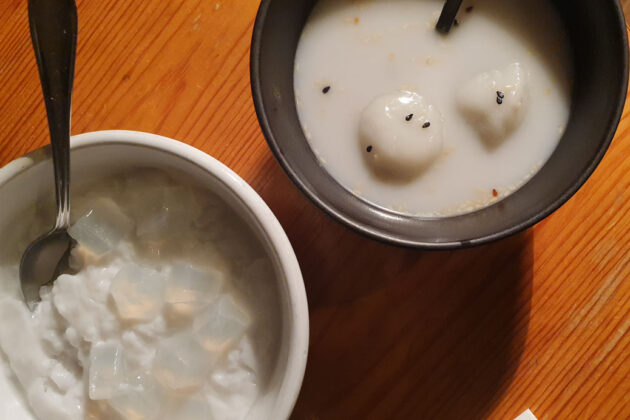
Desserts von Good Morning Vietnam 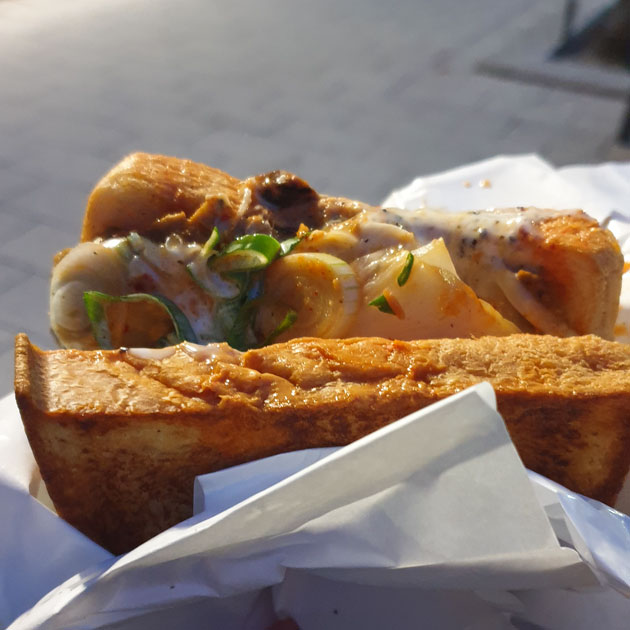
Seitan Kimchi Sando vom Café Kandl
Ein paar Tage später haben wir noch einen Ausflug zum Café Kandl gemacht, wo aus dem Fenster heraus wöchentlich wechselnde Specials verkauft wurden. Wir nahmen die vegetarische Variante, was ich davon gehalten habe, ist hier nachzulesen.
Weil das Wetter endlich wieder schön genug für einen Spaziergang durch die halbe Stadt war, hat sich meine WG eine Runde Cocktails von der Matikibar gegönnt. To-Go im Einmachglas fehlt so einem Drink natürlich automatisch ein bisschen von seinem Flair, aber dank mitgelieferter Deko und Papierstrohhalmen machten die von der Matikibar schon etwas her. Ich trank einen „Alm Colada“ mit Zirbenschnaps, dunklem Rum, Kokoscreme, Ananas- und Orangensaft, dazu gab es eine eingelegte Trockenpflaume.
Ansonsten habe ich super viel Zeit mit Studieren und Arbeiten verbracht, ein paar Links konnte ich dennoch zusammensammeln:
Rezepte
Sesame Tofu With Coconut-Lime Dressing and Spinach Recipe – NYT Cooking
Was macht die NYT, dass ich wöchentlich mindestens eines ihrer Rezepte bookmarke?
Roasted Strawberry-Miso Ice Cream – David Lebovitz
Was für eine Kombi!
Texte
When Podcast Hosts Speak, What Do We Hear? – The New York Times
Großartiges Mulitmediastück über das Sprechen in US-amerikanischen Podcasts.
As host, he [Ira Glass] sounded urban, Jewish, a little fretful. Most of all, he sounded like himself.
In 1998, “This American Life” made its episodes streamable. In 2006, they became downloadable, part of the first wave of podcasts. Many of the show’s contributors and producers echoed Glass’s manner — understated, conversational, pause-friendly. Those contributors and producers created podcasts of their own: “Serial,” “S-Town,” “StartUp,” “Planet Money,” “Reply All,” “Heavyweight,” “Invisibilia,” to name some of the best known. The style of voice proliferated, especially in narrative journalism.
Landkarten: Alles ist erleuchtet – SZ.de
Über Landkarten-Kunst und Wissenschaftskommunikation.
Wer es genauer nimmt, sollte die Karten einzelner Länder nicht einfach nebeneinanderlegen und miteinander vergleichen. Szucs ist das bewusst, aber er meint auch: „Ich habe schnell gemerkt, dass viele Länder ziemlich langweilig aussehen, wenn ich immer dieselbe Farbeinteilung verwende. Hätte ich das getan, dann würde sich niemand für die Karten interessieren.“ Und genau hier liegt das Dilemma – für Szucs im Kleinen, und für die Wissenschaftskommunikation im Großen: Wissenschaftliche Abbildungen sollen nicht nur die Wirklichkeit abbilden, sondern auch gut aussehen, verständlich sein und Menschen erreichen. Im besten Fall sind sie beides gleichzeitig: wissenschaftlich korrekt und schön.
The ancient fabric that no one knows how to make – BBC Future (via @kristymhall)
Über verlorenes Wissen:
By the early 20th Century, Dhaka muslin had disappeared from every corner of the globe, with the only surviving examples stashed safely in valuable private collections and museums. The convoluted technique for making it was forgotten, and the only type of cotton that could be used, Gossypium arboreum var. neglecta – locally known as Phuti karpas – abruptly went extinct. How did this happen? And could it be reversed?
As it happens, so does the Bangladeshi government, who have given the project their backing. „It’s a matter of national prestige,“ says Islam, who is also keen to upgrade the country’s image. „It’s important that our identity is not poor, with a lot of garment industries, but also the source of the finest textile that ever existed,“ he says.
What happened to me was nothing – the nothing women know all too well – The Guardian
Über fast alltägliches Catcalling:
Oh dear. Now I’m seeing the front of his jacket again, and he’s coming back towards me. Can’t he see there are now people around, because I’ve reached the square? But he’s one of the ones that doesn’t mind an audience. What do people who can now see us think is happening, I wonder crossly. Crossly enough to find my voice and say: Stay away from me. I say it loudly and clearly, so the two guys working on the road about 15 metres away will hear. They look up, and I look right at them, quickly because I daren’t take my eyes off The Wonderer. But then they carry on with their work. Come on guys – don’t you read the internet? Hashtag be an ally!
Don’t Just Skip to the Recipe – Skillet Lifehacker (via Vice)
Recipeasly, ein neues Webservice wollte „just the recipe“ vereinfachen, war in Wahrheit aber nur Foodbloggerbashing, oft sexistisch motiviert, kombiniert mit Content-Klau:
Hating on food writers for talking about their families or their lives is not a new trend. About twice a year, someone’s tweet about the tedium of matriarch-focused anecdotes goes viral, and it is exhausting every time.
Can Small-Scale Subscriptions Change Food Media for the Better? – Vice.com
Pivot to newsletter, Foodblogger-Edition:
This shift is happening across media: By necessity and by choice, writers and other creators are leaning on platforms where devoted followers can support them directly, instead of putting all their effort into traditional distribution models like newspapers or magazines. Creators gain a sense of creative control and more appreciation for their labor. Consumers find a personalized experience with more transparency; they’re supporting individuals, not institutions. As more content in the food space moves toward subscriptions instead of ads, the relationship between consumers and creators is changing. In a time when media institutions face greater accountability from consumers, could this model change food media for the better?
Review: Sam Sifton’s ‘No-Recipe Recipes’ – The Atlantic
Der Text ist eigentlich eine Buchrezension, aber dieser Randaspekt ist am interessantesten:
But careful measuring, which originated simply as a way to make home cooking easier and more predictable, over time developed a more distinctive identity. It acquired gender—at the very moment the postwar kitchen was going upscale. Suddenly a fondness for measuring was discovered to be intrinsically female, practically a secondary sex characteristic, like small brains, shrill voices, and no sense of humor. Female cooks follow recipes “to the last decimal point,” complained the New York restaurateur Leonard Jan Mitchell in 1952, whereas a male cook “experiments, embellishes and is no slave to the cookbook.”
Opinion | The Empty Religions of Instagram – The New York Times
Vom Televangelist zum Instavangelist, nur halt ohne christliche Affiliation.
Many millennials who have turned their backs on religious tradition because it isn’t sufficiently diverse or inclusive have found alternative scripture online. Our new belief system is a blend of left-wing political orthodoxy, intersectional feminism, self-optimization, therapy, wellness, astrology and Dolly Parton.And we’ve found a different kind of clergy: personal growth influencers. Women like Ms. Doyle, who offer nones like us permission, validation and community on demand at a time when it’s nearly impossible to share communion in person. We don’t even have to put down our phones.
The Rise and Fall of Getting Things Done | The New Yorker
Über productivity pr0n:
The knowledge sector’s insistence that productivity is a personal issue seems to have created a so-called “tragedy of the commons” scenario, in which individuals making reasonable decisions for themselves insure a negative group outcome. An office worker’s life is dramatically easier, in the moment, if she can send messages that demand immediate responses from her colleagues, or disseminate requests and tasks to others in an ad-hoc manner. But the cumulative effect of such constant, unstructured communication is cognitively harmful: on the receiving end, the deluge of information and demands makes work unmanageable. There’s little that any one individual can do to fix the problem.
Opinion | The Secret Life of a Coronavirus – The New York Times
Wie das Nachdenken über Viren letztlich zum Nachdenken über das Leben selbst wird:
In 1935 a scientist named Wendell Stanley showed the world just how hard it was to make sense of viruses. He dried tobacco mosaic viruses down to crystals, which he could store like table salt. Months later, he doused the crystals with water, and they changed from crystals back to familiar viruses, able to make tobacco plants sick once more.
When Stanley announced his viral resurrection, this newspaper went agog. “Enough is known about matter, organized and unorganized, to assure us that there may be things ’twixt heaven and earth which are not so alive as an eel or so dead as a rock,” The Times wrote. “In the light of Dr. Stanley’s discovery the old distinction between death and life loses some of its validity.”
Frontiers | Algorithmic Profiling of Job Seekers in Austria: How Austerity Politics Are Made Effective | Big Data
Diesen Artikel über den österreichischen „AMS-Algorithmus“ wollte ich eh schon länger lesen, die Motivation dazu geliefert hat mir jetzt ein Seminar, auf dessen Leseliste er steht.
To advocate the usefulness and quality of the system, the AMS praises the objectivity of the algorithm and uses technical performance metrics, such as precision of the prediction to support their argument. The claimed neutrality, objectivity and precision of the algorithm fuels the idea of the efficiency of bureaucratic work and ultimately of a “lean state.” However, as our analysis shows, the precision of the algorithmic prediction cannot be taken for granted in practice and case workers are supposed to act as a “social corrective.” In addition to the burden of justifying any changes of the “objective” classification of customers resting with the case worker, the responsibility to correct the system and to make cost efficient decisions is ultimately delegated back to the case workers as well.
Audio/Video
Mira Lu Kovacs – Stay A Little Longer
Mira Lu Kovacs neues Album (dieser Song ist wohl die „Singleauskopplung“ oder so ähnlich) gefällt mir sehr.
Sonst So
Surf’s Up. The Temperature Isn’t. – The New York Times
Fotostrecke über Surfer, die im Winter auf kanadischen Seen Wellenreiten.
Foto
Ein neues Strickprojekt.
Backkatalog:
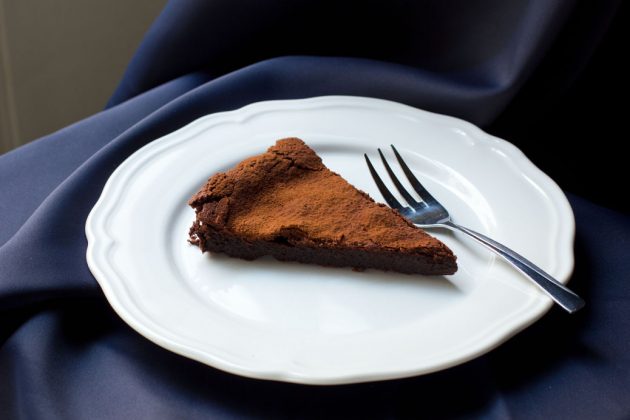
Low-Carb-Schokokuchen 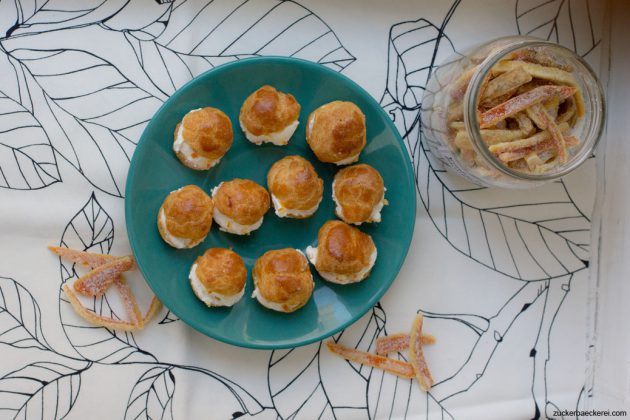
Orangen-Brandteigkrapferl 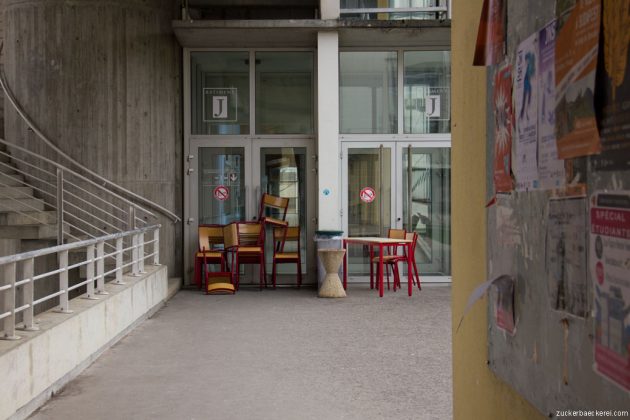
Zuckersüß 280 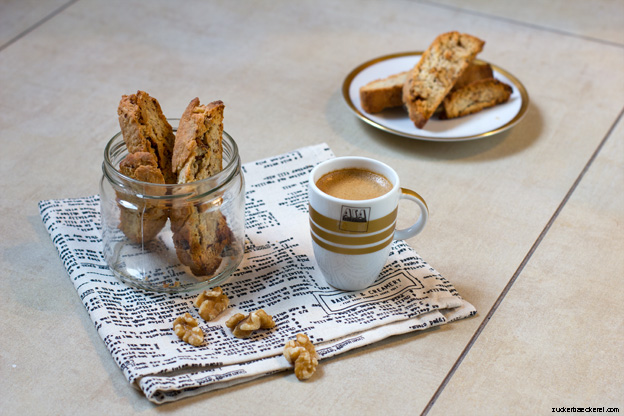
Cantuccini mit Walnüssen 
Karotten-Scones mit Rosinen 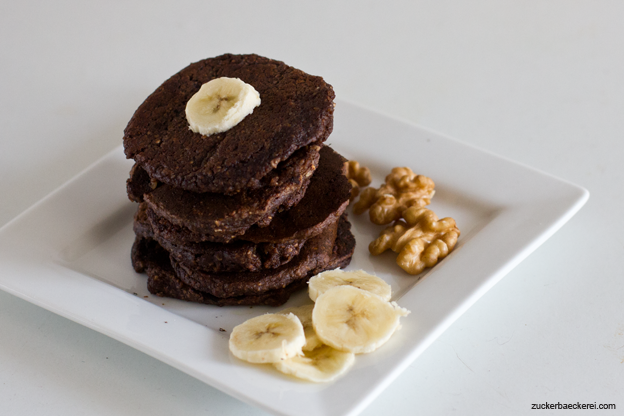
Bananen-Schoko-Pancakes 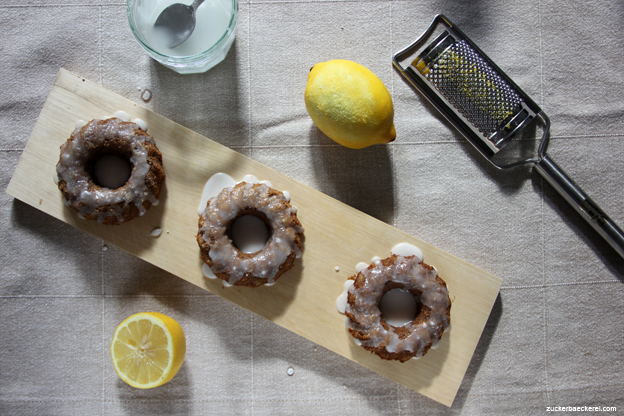
Zitronen-Hirse-Guglhupfs 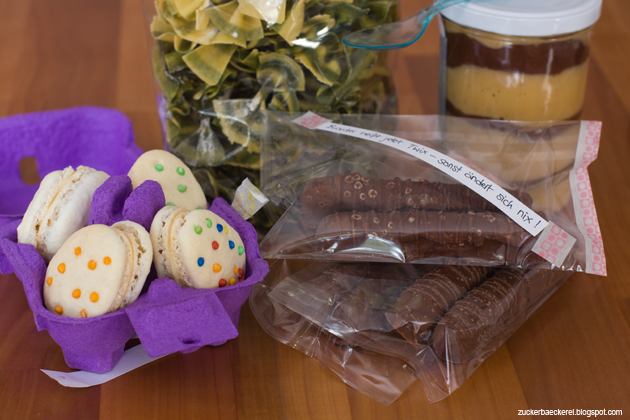
Post aus meiner Küche #5 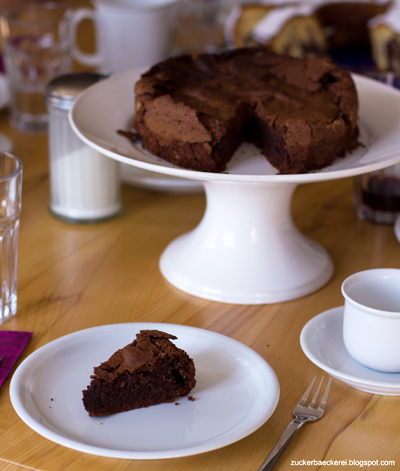
Mandel-Schoko-Kuchen ohne Mehl 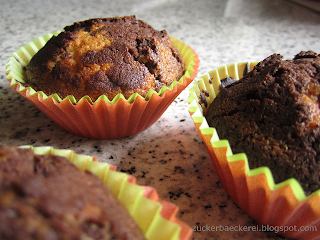
Mascarpone-Marmor-Muffins 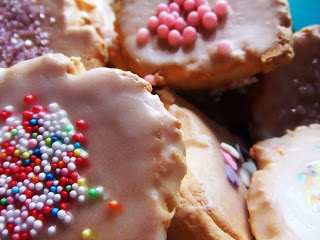
Amerikaner
- 2020: Low-Carb-Schokokuchen
- 2019: Orangen-Brandteigkrapferl
- 2018: Zuckersüß 280
- 2017: Cantuccini mit Walnüssen
- 2016: Karotten-Scones mit Rosinen
- 2015: Bananen-Schoko-Pancakes
- 2014: Zitronen-Hirse-Guglhupfs
- 2013: Post aus meiner Küche #5 – Kindheitserinnerungen
- 2012: Mandel-Schoko-Kuchen ohne Mehl
- 2011: Mascarpone-Marmor-Muffins
- 2010:Amerikaner

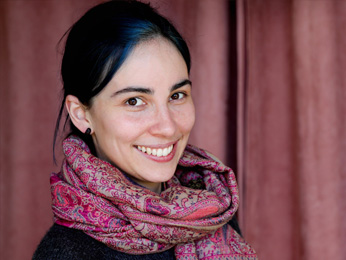 Hi, ich bin Jana. Seit 2009 veröffentliche ich hier wöchentlich Rezepte, Reiseberichte, Restaurantempfehlungen (meistens in Wien), Linktipps und alles, was ich sonst noch spannend finde. Ich arbeite als Redakteurin bei futurezone.at, als freie Audio-/Kulinarikjournalistin und Sketchnoterin. Lies mehr über mich und die Zuckerbäckerei auf der
Hi, ich bin Jana. Seit 2009 veröffentliche ich hier wöchentlich Rezepte, Reiseberichte, Restaurantempfehlungen (meistens in Wien), Linktipps und alles, was ich sonst noch spannend finde. Ich arbeite als Redakteurin bei futurezone.at, als freie Audio-/Kulinarikjournalistin und Sketchnoterin. Lies mehr über mich und die Zuckerbäckerei auf der 

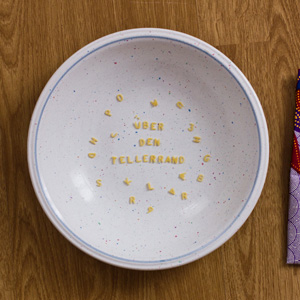 Über den Tellerrand
Über den Tellerrand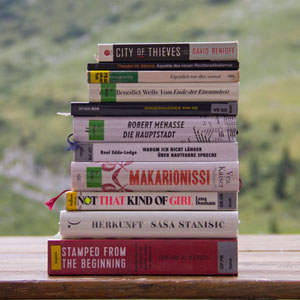 Bücher
Bücher Zuckersüß
Zuckersüß